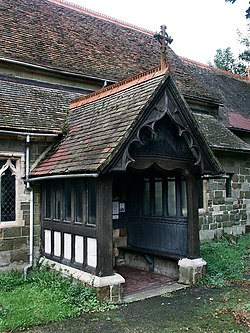Bucknall, Lincolnshire
| Bucknall | |
| Lincolnshire | |
|---|---|
 Porch of St Margaret's Church, Bucknall | |
| Location | |
| Grid reference: | TF176688 |
| Location: | 53°12’13"N, 0°14’25"W |
| Data | |
| Population: | 364 (incl. Tupholme, 2011) |
| Post town: | Woodhall Spa |
| Postcode: | LN10 |
| Dialling code: | 01526 |
| Local Government | |
| Council: | East Lindsey |
| Parliamentary constituency: |
Louth and Horncastle |
Bucknall is a village in Lindsey, the northern part of Lincolnshire. The village is situated approximately five miles west of Horncastle and five miles north of Woodhall Spa.
Two small streams in the village flow south to meet the River Witham. Farms around the village raise cattle and crops. Many birds typical of farmland are found in the village, including house sparrow, common starling and barn owl. Notable flora includes Verbascum thapsus, Tanacetum vulgare and Aesculus hippocastanum.
Parish church
The parish church is dedicated to St Margaret.[1] The west chancel of the church was restored in 1884 by James Fowler. The north nave and door, set within a later timber porch, are Early English Gothic. The south nave is decorated gothic, and the font late Norman.[2] The pulpit was given to the church in 1646, and there exists a 1787 chalice, flagon and paten by John Wakelin and William Taylor.[3]
History
A Neolithic stone axe and Roman pottery fragment have been found around the village.[4]
The first historical reference to the village is from the Saxon Charters of 806 AD, in which it is referred to as Bokenhale. In the Domesday Book of 1086 the name is spelled Buchehale.[5] It seems likely that the village name means remote/hidden place where the goats are. 'Boken-'/'Buche-'/'Buckn-' could stem from 'bucca' an Old English word for a he-goat.[6] 'Hale' is an old English word meaning a recess, nook, or remote valley.[7] Other theories are that the village is named after a man with the old English name Bucca, that it's a reference to deer (buc in old English), or that it refers to beech trees (bok in old Norse).[8]
It is claimed that the historical figure Lady Godiva was born in Bucknall around 995 AD, however several historians have declared the charter document used as evidence for this to be spurious.[9]
Four miles west of the village there is a ruined mediæval abbey called Tupholme Abbey, which was built at a similar time to St Margaret's Church.
Bucknall also has an 18th-century Grade II listed rectory,[10] A post office previously existed adjacent to Nightingales Nursing Home. In the 1960s a farm in the village overwintered donkeys from Skegness beach. Since the 1990s two cattle farms within the village have been developed for housing. There was previously a farm shop opposite the church and a petrol station at the east end of the village.
Amenities
In the village there are a small primary school, a nursing home, post boxes, a village hall, a small park and public footpaths.
Outside links
| ("Wikimedia Commons" has material about Bucknall, Lincolnshire) |
References
- ↑ National Heritage List 1359927: Church of St Margaret (Grade II listing)
- ↑ Cox, J. Charles (1916) Lincolnshire p. 85; Methuen & Co. Ltd
- ↑ Nikolaus Pevsner: The Buildings of England: Lincolnshire, 1964; 1989 Penguin Books ISBN 978-0-300-09620-0
- ↑ Archi UK
- ↑ The Internet Surname Database
- ↑ Oxford Living Dictionaries - Buck
- ↑ Family Names of the Island of Newfoundland
- ↑ Surnames of the United Kingdom
- ↑ The Earls of Mercia: Lordship and Power in Late Anglo-Saxon England
- ↑ National Heritage List 1308861: The Old Rectory
